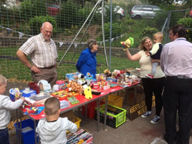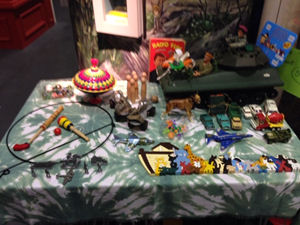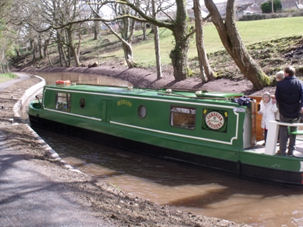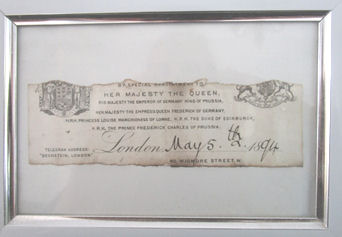Dates for your Diary
Saturday 28h September – Coffee Morning - Victorian & Edwardian Children’s Clothes
Saturday 9th November – Coffee Morning – Remembering Remembrance Day
Saturday 30th November - Winterfest
September 100 Club
No. 10 Grace Bearcroft £20
No. 03 Colin Price £10
If you would like to join our 100 club and be in with a chance of winning, it costs just £1 a month. Ask at the museum for further details.
Winterfest
Winterfest is on a Saturday this year (30th November) and as usual we need items such as chocolate bars for crackers, tins, packets, bottles etc for our tombola stall and bric-a-brac for our white elephant stall as well as cakes on the day. All donations gratefully received, please bring to the museum ASAP.
Six Bells Fayre
 Thanks to our small band of volunteers and our customers alike, the museum stall made over £50 at the recent fayre at Six Bells park. This came hot on the heels of the Abertillery ‘Party in the Park’ where we made over £100.
Thanks to our small band of volunteers and our customers alike, the museum stall made over £50 at the recent fayre at Six Bells park. This came hot on the heels of the Abertillery ‘Party in the Park’ where we made over £100.
Changes to Bus Passes
All current bus passes will expire on 31st December. To apply for the new style card visit www.tfw.wales/travelcards and select ‘Replace an old-style card’. Follow the instructions as you fill in the online form. Alternatively, to receive a form by post, telephone 0300 303 4240.
Thank you
The museum is very lucky to have many supporters from regular members to Vice Presidents and those who come along to our coffee mornings plus of course our small band of volunteers. One lady, who wishes not to be named, recently donated £100 to the museum. Thank you, one and all. We couldn’t keep going without you!
Congratulations
We would like to congratulate Bethan Gilson on passing her exams. She has graduated from Exeter University with a First Class Honours Degree in History. Bethan volunteered at the museum for a number of years before going to university and got her father, Richard, involved as well. Richard has now been deputy curator for about 6 years. Well done Bethan!
Toys
How long do you think toys have been around? Take a guess. Well, they have certainly been around for 4,500 years as dolls representing human figures, animals and soldiers have been found at archaeological sites dating back to that time, along with miniature versions of adult tools. There is no reason why toys shouldn’t be much older that that, perhaps going back to early man – 200,000 years ago. Whenever they emerged, the fact of their existence shows us not only that children have always enjoyed playing with toys but also that their parents card enough about them to make or somehow acquire those toys. We may be reading too much into what has been found at those archaeological sites but as parents and grandparents it’s difficult to look at it any other way.
So what is a toy? What exactly are we talking about? One definition of a toy is an item used for play, especially an item designed to be used that way, although we all know that children can make toys out of just about anything, from an empty cardboard box to an empty cake tin and wooden spoon! We can widen the definition of toys to include games – both board games and sports items such as hoops and balls and once again, this goes back into history.
Nowadays, with the benefit of modern understanding of human behaviour, we know that playing with toys is an important part of a child’s development. They help to develop manipulative and social shills, spatial awareness and much more. As with the way animals in the wild play to equip themselves for adulthood, so our children’s play also helps to equip them for their life ahead.
At the museum we have a wonderful selection of toys, from a simple doll carved from a piece of pit prop, to die-cast models, kites, jigsaw puzzles, ride-on toys and much more. Our most unique toy is the wooden doll mentioned above which was carved from a section of pit prop by a father for his daughter, the pit props being used underground to hold up the roof of the tunnels. This doll is well over 100 years old and can be seen in the mining display case.
Another toy of interest at the museum is the dolls pram which was bought in the Bon Marche in Abertillery, usually by means of their ‘Christmas Club'. This is also over 100 years old and can be seen displayed above the door of Ashe’s Shop.
A further item of interest are our metal soldiers which were home-made by our curator, Don Bearcroft, by means of melting down old lead piping and pouring into moulds purchased from none other than our very own Ashe’s Shop!
Do pop in and have a look and if our modest collection whets your appetite, there are museums all around the world devoted to toys. The Toy Museum in Brighton is home to over 10,000 toys but that pales by comparison with The Toy Museum Complex in Branson Missouri, which has over 1 million toys!
Jen Price

Some of the toys that can be seen at the museum
Chartist Convention
10-3pm Sat 2nd November 2019,
St Woolas Cathedral Newport
Theatrical re-enactment, plus a wide range of stalls and other Chartist and historical material. For more information and to buy tickets, visit
www.newportrising.co.uk/events/chartist-convention
Canals
What comes to mind when you think of a canal – our own nearby Monmouthshire & Brecon Canal for instance? The scene today is mostly one of tranquillity, a quiet waterway snaking through open countryside, often with trees arching over the water. Now think back to the start of the 19th century and imagine what the canal was like in its heyday, including the Crumlin arm which opened in 1799, with the other arm being open along its full length to Brecon in 1812. The days of moving goods around by packhorse and horse and cart on roughly laid roads and tracks largely ended with the era of the canals which were built to facilitate the efficient and economic transport of bulky materials and produce. This was the start of the Industrial Revolution when the scale of production and distribution changed dramatically.
The small number of diesel and petrol engine narrowboats which use the canal today are a far cry from the large numbers of boats which must have travelled the canal in its heyday, boats pulled by horses from the towpath. Remember, there is a single towpath and so it must have been a potentially hazardous but well practised manoeuvre when boats (and the horses with their tow ropes) going in opposite directions needed to pass each other. I have read that on some longer canals the towpath switches from one side to the other, the purpose being for the horse not to be constantly pulling from the same one side of its body and thus ease the strain (somewhat). I can only think of one section where the towpath changes sides and that is on the stretch south of Cwmbran.
The scale of traffic on the canal in its early years as an industrial waterway meant that where goods were loaded and off loaded, facilities were needed for storage, accommodation, stabling, the provision of men to maintain and repair the canal and shoe the horses and a host of other related activities – you can imagine the scene. And the noise!
The rise of the railways meant that the canal’s use declined from about 1850 onwards. In the subsequent years some sections of the canal fell into disrepair and some sections disappeared altogether. We are lucky today to have such long stretches of the canal available for our quiet enjoyment but what stories those sections could tell us if they could only speak. Some years ago a guest speaker told us about the catastrophic collapse of a section of the canal at Cwmcarn – that is just one story. There must be many more. How little we know of our past!

Jen Price
If Only They Could Speak…
My first major purchase after I started work was a beautiful, glossy Bechstein upright piano. It was second-hand; an elderly lady with arthritic fingers handed it over reluctantly. She’d cherished it but could no longer play it and an instrument like that demanded to be played. She told me it was made in the 1900’s but when I checked the serial number, I found it was even older. My ‘new’ purchase, in fact, dated from 1890.
Over the years that elderly instrument has given me hours and hours of pleasure and relaxation. When I moved home, it came too, taking up too much room in our small terraced house but filling it with joy.
But then, my lovely piano became home to an infestation of moths. I called the piano tuner in a panic. He came, took apart the action, vacuumed up all the eggs and the larvae and the adult moths and sprayed foul-selling chemicals on the felt and leather before painstakingly fitting it all back together. As he was leaving, he nodded to two thin strips of rolled up brown paper he’d found in the depths of my piano. They looked like old fly paper. “I’ll put them in the bin,” I told him. He looked at me strangely then took his fee and left.
I picked up one of the paper rolls. It wasn’t fly paper. Leathery and brown with age, it was a torn-off, left side of a hand-written note with a printed symbol at the top. The writing was in a bold, scrawling, old-fashioned hand and the first word on each line was still clear enough to read. The unconnected words made no sense; it was impossible to guess what the note was about. There was mention of a “Fee” of 1/3d but that was all. The symbol at the top, though, was clear enough. The wording on it read, “Manchester Unity of the Independent Order of Odd Fellows”. Now that was interesting. In my late twenties, having lost touch with all my school friends and needing a new social circle, I joined the Cardiff branch of the Youth Hostel Association Local Groups. It changed my life. I made long-standing friendships, gained enough confidence to travel, go to university, try lots of new things. And the place they held their meetings? - The Oddfellows Club on Newport Road, Cardiff.
I moved on to the second roll of paper. Again, it was an inch or so wide and torn from a larger piece of paper. This time the tear was horizontal so a complete, handwritten date – May 5th, 1894 – could be read easily. Perhaps it was part of the receipt given to the first purchaser or maybe part of the registration document showing when the piano was manufactured. Either way, it was a tangible though fragile link with the past. A piece of history that I’d nearly thrown out with the household waste!
“By special appointment,” it read, “to Her Majesty the Queen”. In 1894, that must have been Queen Victoria, of course. “Her Majesty the Empress Queen Frederick of Germany,” it continued. Curiosity aroused, I ‘Googled’ her and found that she was Queen Victoria’s eldest daughter who met her future husband when she was ten or eleven and married him when she was just seventeen. He was a good deal older than her and she was only Empress for 99 days as her husband died of cancer of the larynx a few months after becoming Emperor.
“H.R.H. Princess Louise Marchioness of Lorne”; it went on; that was Queen Victoria’s sixth child, whose husband, John, Marquess of Lorne, was appointed Governor General of Canada in 1878. Lake Louise, between Banff and Jasper in the Canadian Rockies, is named after her.
“H.R.H. the Duke of Edinburgh”; followed next; that would have been Alfred, second son of Victoria and Albert. He was, apparently, fond of music and helped to establish the Royal College of Music in London.
And lastly, “H.R.H. the Prince Frederick Charles of Prussia”. Prince Frederick was a military man, known as ‘the Iron Prince’, and nephew of German Emperor Wilhelm II. I wonder what use he had for a Bechstein piano?
So many mentions of things that no longer exist – Prussia, the German monarchy, the people who claimed their aristocratic or regal titles only to be superseded by sons, daughters, grandsons, granddaughters – it all seems to belong to another world.
At the bottom, there is, instead of what today would be an email or website address, a telegram address. Then, under the handwritten date is a London address: 40 Wigmore Street. Just north of Oxford Street in central London, Wigmore Street was the home of the Bechstein London branch which opened in 1885 (Carl Bechstein made his first pianos in Berlin in 1853). In 1901 the Bechstein Hall was built next door. In 1916, due to the growing hostility to German brands, the showroom, pianos and concert hall were sold and renamed. The Bechstein Hall is now the Wigmore Hall, a world-renowned venue specialising in chamber and instrumental music.
That small, torn piece of paper (pictured below) is now framed and positioned on top of my still-loved and regularly played Bechstein piano. I have learnt so much from its few words. What I can only imagine, though, is what of my beloved instrument’s own history? Who bought it first? And why? Were they members of the Oddfellows? Did my piano travel up to Manchester before ending up in Caerphilly by way of Cardiff and Abercynon?
If only it could speak…
Kay Bingham

Sources:
www.Wigmore-hall.org.uk
www.bechstein.com/en
www.cracroftspeerage.co.uk
Top Of Page
